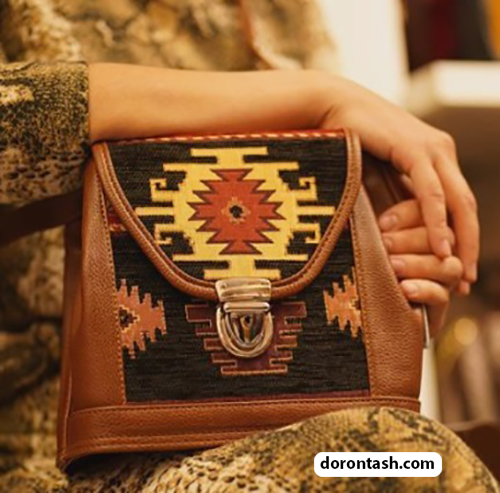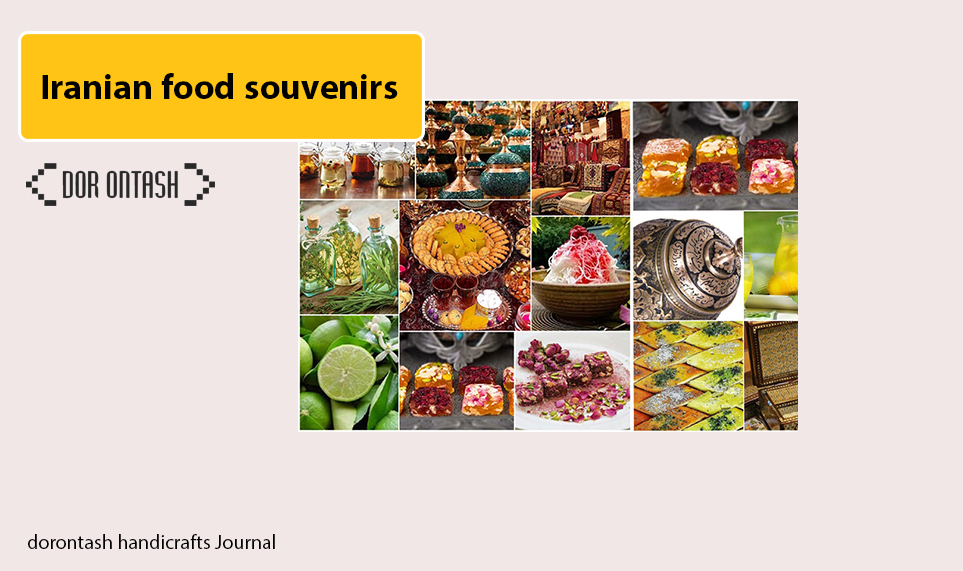The importance of animal motifs can be seen in Iranian art from a long time ago. These animal motifs are sometimes considered as a symbol of gods, royalty or elements of the universe due to their use in agriculture and nutrition. Among the animal motifs, the goat horn pattern motif is very important.
In ancient times, this role had more than a decorative role, and it is a symbol of the benefactors and blessings. From the Sassanid era and then the Islamic era, when the beliefs and tendencies of art and culture have undergone fundamental changes, the goat horn patter image also went to the sidelines and kept most of its function in rural and tribal handwovens.
The purpose of the leading article is to search for the reason for the continuation and preservation of this role in ancient art and then its continuation in kilim art. This research has investigated the traces of Bezkohi’s presence and its meaning in Iranian art with the help of the available paintings from the prehistoric era until now, with the method of comparing the documents left behind in different eras and the descriptive-analytical method. The method of collecting information is also a library.
It seems that this role has existed on the petroglyphs for a long time and according to the beliefs and rituals of the past people, it was formed as a symbol of rain, fertility and abundance, and it was transferred from one generation to another in the art school, and it was preserved in the nomadic handlooms that were safe from the changes of the day. Is. The closeness of this role with the life, livelihood, environment and wishes of the weaver and its traditional transmission over the centuries is the cause of its preservation among the nomadic weavings until today. Even though today’s weaver is aware of the exact meaning of this role, he is the guardian of it, and in this way, the kilim has become a symbol of an ancient image and ideal.
The importance of animal motifs Before this, people thought that natural phenomena, such as rain and storms, fertility and fertility of the soil, were under the supervision of invisible forces. In order to control nature and create a favorable behavior in it, man does whatever he thinks is effective in order to achieve recovery, blessing and mastery over the environment. With the rise of the moon, the tide would rise, the sound of a bird could be a promise of rain, an animal His four legs led him to a spring in the mountains and desert. The instinctive behavior of animals in predicting natural events and finding water and wildlife resources gave humans the impression that they play a role in creating events and what is desirable.
Ancient artists created animals based on their ideas of mud, stone, and metal, which, from their point of view, had mana power and were influential in events and nature. Animals were sometimes respected or worshiped as ancestors or totems in ancient times and were praised for their beauty or natural strength.
The image of an antelope goat horn pattern in Iranian art
The image of ibex has played a very important role in Iranian art for a long time, and its images have been seen since prehistoric times in the motifs of caves, carved stones, on pottery and metal vessels. This role can be seen either in a natural form or in a winged form in the art of Lorestan bronzers, and in the Achaemenid period, it reached its highest glory in terms of the variety of forms, and over the centuries it is a symbol of life force, fertility and the guardian of the tree of life. Came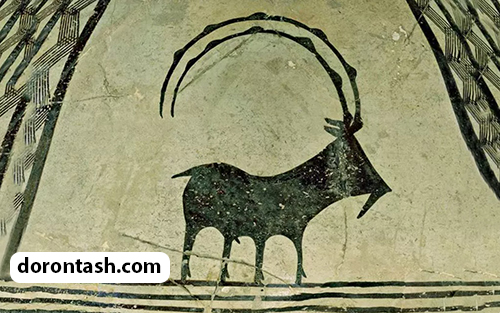
In some sources, the Bezkohi image is an animal symbol of Gil Gomesh, the Sumerian king is also the lord of animals and the symbol of Anahita, Izdbaran. In the prehistoric era, goat images were painted and carved on rocks, and the potters of Susa always put the moon or other symbolic images between the horns and trunk of the goat, and a large number of Susa clay drinking troughs in the 3rd and 4th millennia. They have no role other than this
Undoubtedly, the identity of Iranian quadrupeds is affected by the environmental, cultural and ritual conditions of these people. It can be said that some artistic phenomena were affected by the social conditions of the way of life of the people of their time and it shows the importance of some creatures and subjects in the nature around the people who made them.
The main goal of this research is to understand the meaning and concept of Bezkohi painting and its continuity in Iranian art from ancient times until now. Considering the changes in the conditions, customs and ways of living of Iranians in the past centuries, the image of goat in various forms in the handcrafts and handwovens of Iranian peoples has consistency and durability.
Why is the goat horn pattern so repeated in ancient Iranian art?
The main question of the upcoming research is why the role of goat was repeated to such an extent in ancient Iranian art and what was its fate in the later era?
For this purpose, the role of Bezkohi from petroglyphs, pottery and metalwork among the available and available documents from ancient history and civilization to nomadic rugs in the contemporary era has been investigated and studied.
Also, this role has been examined among the motifs available from hand-woven fabrics, especially the kilims of the nomads of Bakhtiari, Shahson and Qashqai regions, with reference to its background in ancient art. In this research, the importance of Bezkouhi painting in terms of its meaning, function and connection with mythology, beliefs, beliefs, and rituals in different historical periods and its continuation in the contemporary era has been investigated.
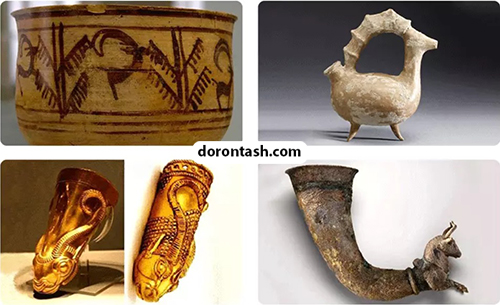 Mountain goat horn pattern morphology
Mountain goat horn pattern morphology
There are various forms of goat depictions in ancient art, and sometimes due to the similarity with other quadrupeds such as rams, goats, and marals, its exact identification is doubtful, and in some texts it is named incorrectly. Therefore, it is necessary to first describe the appearance of these quadrupeds. be expressed
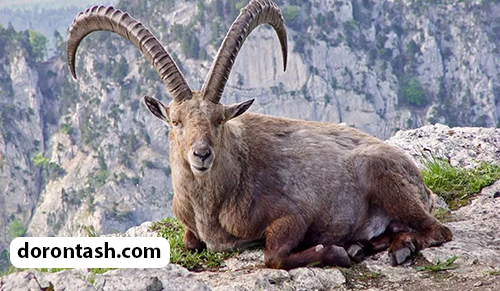 ram
ram
Herdsmen and early animal husbandry communities in the Iranian plateau considered the ram to be a symbol of superiority over other animals, especially sheep, and the main characteristic of the ram is its snail-shaped horns. The ram is one of the male gods associated with fertility and reproduction, and in Egyptian mythology, it is the symbol of Amon, the god of creation, and Khnum, the god of creativity.
Maral, Deer, Mountain Cow This animal, which belongs to the family of deer, has long and multi-branched horns, and its horns grow longer than yellow deer and up to 110 cm. The habitat of this animal, which is often confused with an ibex, is mostly in the northern regions of Iran. This animal does not have the distribution and extent of its habitat like the mountain goat.
goat horn pattern on pesrian kilim bags
Gazelle
This animal is also scattered throughout Iran. Its horn grows up to 44 cm, its legs are long and its neck is long and its horns are short and towards the back. In general, it is smaller than Meral, Bezkohi and Koch
Kal, guard, mountain goat
The mountain goat is scattered in almost all the provinces of Iran and mountainous areas.
The goat easily climbs the rocks, its horn is sword-like and beautiful, and the animal is estimated from the protrusion on the horn. Its tail is short and its length is slightly longer than the length of the ears with hairs at the end. Its legs are strong and its hoof is relatively wide. (Picture 2)
The motif of an antelope is seen for the first time on the beads of the Mesopotamian shaped cylinders belonging to the 4th and 3rd millennia BC.
goat horn pattern on Iranian petroglyphs
Stone carvings are the oldest books of early humans, on which they recorded their interests, tastes and beliefs. About 30,000 to 25,000 figures have been carved in the heart of the mountains and caves, and it can be safely said that the most abundant figure found in the petroglyphs is the mountain goat, especially the male goat, with large horns drawn in various styles, which are prominent in most of the scenes. slow (Farhadi, 1377, 130)
Due to the widespread distribution of this animal in Iran, this role has been seen in the petroglyphs of the mountainous regions of Lorestan, Arsbaran, Kahkiloyeh, Khomein, Dasht Maghan and other regions of Iran.
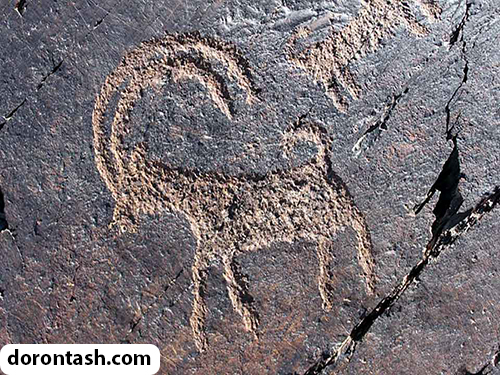
A mountain goat with long horns turned back and a narrow neck of ninety degrees is a sign recorded in the petroglyphs of different regions of Iran, and it means asking for water, fertility and abundance of blessings. It is a mountain goat. (Nasseri Fard, 1388, 133) Next to the carvings discovered from Bezkohi, there is a rhombus-shaped carving that is from the collection of mixed lines of ancient Elam, and the archeology professor confirmed to Hintz the existence of a ziggurat-shaped carving near this design. It is sacred. Mountain goat motifs are often found in areas close to water, and even today it is considered one of the blessed areas. In this period, the role of a mountain goat is seen everywhere as a mythical and holy angel, the guardian of the moon and the requester of water, fertility and abundance (ibid., 134).
Painting for humans in the ancient period is considered as their first line of writing, and the hope for fertility and blessings is greater, and it can be definitely said that the role of the goat as a symbol of the moon and rain is more than other animals such as sheep, horses, deer and lions for the past people of Iran. It is important and its abundance is a sign of importance in their lives and beliefs
Due to the fact that the goat is resistant to heat and inaccessible, mountainous areas and low vegetation and is a native game of Iran, the vital importance of this animal in the livelihood and living of the nomads is obvious. On the other hand, for ancient people, the horn of this animal is reminiscent of the moon
The importance of the moon according to its relationship with plants, water and rain, which is a manifestation of supernatural power. Rain is vital in nature, it is divinity, kingship, power, victory, abundance of flocks and crops, birth and fertility. Also, the manifestation of life force with the vital principle that rises from the head; Hence, the horns on your helmet or headgear give extra strength. Horned gods are also considered to be the embodiment of warfare, fertility, and the lord of animals. (Cooper, 218, 2019)
It can be said that the role of an antelope was used more than other animals in bronzes and pottery of millennia BC. This animal, which in ethnic and mythological beliefs, is the male principle and the symbol of the power of production, is one of the animals ruling the heavens, the tenth sign of the zodiac and also one of the constellations in the northern sky that Iranians Ibex and other horned animals also believed in eternal power, and there was a strong possibility that there was a connection between the curved horns and the crescent moon. Since ancient times, the moon has been associated with rain and the sun with heat and drought
Therefore, the horn is considered effective in raining, and this water dependent was prominently displayed on the dishes, and the crescent moon was always depicted as a water tank in the middle of the crescent of the horns. And the square is a sign of the earth, because it has four main directions, and the sky also appears in the form of birds that have opened their wings. (Pope, 1380, 15)
According to these mystical and magical meanings, one can understand why the role of horned animals is clearly and strongly expressed in artistic examples.
goat horn pattern in Iranian myths
Myth is the response of human inability to not knowing the real causes of events and trying to interpret them. The nature of myths is described by symbols, because symbols define the relationships and connections between the signifier and the signified, human and God. (Cooper, 1379, 1399)
Girishman believes that the Iranians and the Vionanis, in their art periods, narrate mythological subjects. These works were seen in Iran first in pottery and then in metal artists, and they were engraved on metals for at least two centuries in Lorestan. (Girishman, 1374, 74)
In one of the myths related to the story of the creation of man, there is a story of a plant with two leaves (probably rhubarb) growing in the shape of a man, which is known as Mishiyeh and Mishyaneh, and in the events that happened to them, they drank the milk of a white goat. In other words, the goat plays an important role in early human life. (Carnoy, 1383, 51)
In the myths of ancient Iran, among the gods who are represented in the form of quadrupeds, we can mention Vartharghneh (Bahram), the god of war and victory, who is an abstract being, and one of his incarnations was a male goat. (Hinels, 1374, 71)
Examining the pattern of antelope in clay drinking troughs of 4000 BC in Susa, it is evident that the horns are of unusual dimensions, which are considered a symbol of the moon and the source of rain, and in most cases, a symbol of the earth, water, and sun is depicted among the horns. (Figure 4)
There is an undeniable connection between the moon, water and water in the ancient myths of the world, especially the myths of the Indo-Vairanis, who are the ancestors of the people of the Iranian plateau. The connection of the moon with tides, storms and rain strengthens its connection with plants
It is stated in Yashta in Yashta (VII, 4): Plants grow in the warmth of the moon. The connection of the moon with plants and vegetation is such that some of the fertility gods are also lunar gods at the same time, such as Hathor in Egypt and Anahita in Iran. In other cultures of the ancient world, creatures such as dogs or snails, snakes, eels, and frogs are related to the moon and rain.
In the culture of ancient Iran, in addition to the fact that the ibex is a symbol of Bahram, the god of victory, its horn is also a reminder and sign of the moon, so among its horns there is a symbol of water (rain) or earth, which refers to vegetation. (Picture 4-5)
In the bronzes of Lorestan, a mountain goat appears next to Anahita and is a reminder of the god of fertility and water. Among the remains of votive pieces whose exact meaning is not known, there are images of goats, tools and tools related to horses (under series) and simple figures in the form of pins, which may be related to family emblems or made for sacrifices, eyes and eyes. or objects that represent the hero’s fight with two forest animals can be seen
One of the most important bronze works of Lorestan is the bronze rods that were found in a shrine in “Sorkh Dem”. These rods lead to a circular plate, in the center of which there is a prominent figure of a human head, which should be the head of the “Mother God” of the tribes. It is an Asian that has been worshiped from Asia Minor to Susa. (Girishman, 1371, 48)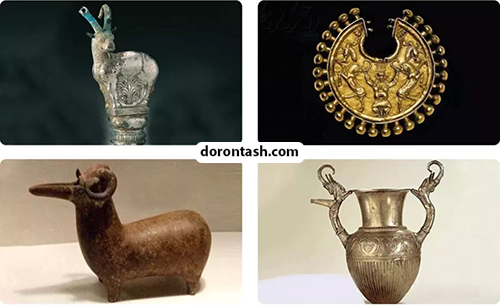
goat horn pattern and legends in hand-woven rugs
Myths are part of the cultural values of every society, as Eliade said, symbols, myths and rituals should be judged as cultural values. In the common language of the 19th century, myth was anything that contradicted reality. In primitive societies, the myth is the actor of absolute truth because it expresses a sacred history, so the myth here is real and sacred and repeatable. The creation of a myth requires special conditions. Our thinking again is myth as an element of civilization.
In fact, myth and mythic behavior are about breaking away from the unholy time and integrating with the origin. Creating a model for the whole society is one of the characteristics of the myth. Perhaps the effort to free the modern man from the origin of his history is the return to the mythical way of life. It is only in modern societies that man finds himself captured by daily work from which there is no escape, and because he can no longer escape from time during idle hours.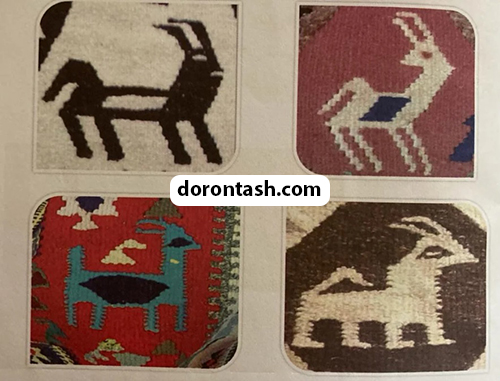
The defense against the time when every mythical attitude appears is in fact inseparable from human conditions and appears in different ways and changes in the new world. But more than anything, this issue shows itself in human preoccupations and entertainments. Therefore, this mythical attitude can be found in the entertainments and unconscious psychological activities of people, such as dreams and human fantasies, according to All the concepts and definitions that are presented in the field of myth, it should be acknowledged that the scope of myth is used in all areas of social and individual life. An example of this use can be found in the entry of myth into literature, philosophy, religion and religion, sociology and art. Art and myth shows its importance when after knowing different myths, we find that these concepts have solidified their foothold in the foundations and principles of artistic works.
The discussion of Iranian hand-woven kilim and the myth of their associations reminds us of the role of kilims. However, in this brief, there is no time to examine the basis of Iranian kilim patterns, the number of which exceeds hundreds of patterns in the whole country, and explore their connection with myths. However, as much as possible and with reference to the deep studies and researches of the Iranian kilim masters, an attempt is made to list some of these examples here.
goat horn pattern symbol in historical developments
The motifs of many animals throughout history on walls, historical monuments and temples, various utensils and tools, seals, etc. clearly indicate the close interaction between humans and the animals around them. In addition to the undeniable role of every
Of the animals in the ecosystem and natural cycle, their role in history, culture and art and the impact they have had on the lives of the people of Iran throughout history is also very important and worthy of attention.
The oldest rock carvings, paintings on pottery and seals left from ancient times clearly show that the first hunters in the Iranian plateau used spears, arrows and bows, especially with the help of sharp-legged hunting dogs that they had in their possession. They hunted them to use their meat and skin (Golshan. Ali. 2013: 37).
The role of prehistoric pottery, which shines on the world’s great museums, shows the culture, art and high thought of man of this period in the land of Iran. An important part of the history of symbols and motifs in different cultures and civilizations lies in the body of works that are studied as authentic documents. From the beginning of creation, the artist has always tried to establish an objective relationship with the world around him and the audience by creating the work and has carried a message to the viewer. During the era of type and quality, this communication has changed from visual to religious and cultural values. Tolstoy considers art to be the highest manifestation of the idea of God in spiritual and spiritual pleasure for humans.
 There have always been connections between man and God, which ancient artists depicted in the majority of symbols (Cooper. 1379: 1), which are symbols such as life force, supernatural force, divinity, monarchy, war, victory, increase of crops and Fertility can be mentioned. Also, the nature of myths can be seen through the representation of symbols in a work of art. Because in the distant past, myths have been a visual reflection of ancient man’s inability to know the real causes of events, as well as the visualization of emotions to reduce troubles or protest against unjust events (Amouzgar. 2018: 18). By studying the works left from the pre-history of Iran, there has been a lot of dispersion in the distribution of the presence of the motif of antelope in ancient Iran (Afzal Toosi. 1391: 56). observed in Iran.
There have always been connections between man and God, which ancient artists depicted in the majority of symbols (Cooper. 1379: 1), which are symbols such as life force, supernatural force, divinity, monarchy, war, victory, increase of crops and Fertility can be mentioned. Also, the nature of myths can be seen through the representation of symbols in a work of art. Because in the distant past, myths have been a visual reflection of ancient man’s inability to know the real causes of events, as well as the visualization of emotions to reduce troubles or protest against unjust events (Amouzgar. 2018: 18). By studying the works left from the pre-history of Iran, there has been a lot of dispersion in the distribution of the presence of the motif of antelope in ancient Iran (Afzal Toosi. 1391: 56). observed in Iran.
The first artistic signs, including carvings on bones, paintings on the walls of caves, and carvings on rocks, show the human tendency to develop religious beliefs and rituals (Malek Shahmirzadi. 1391: 130).
Iranians had a special skill in making engraved dishes. By comparing their creations with similar lands, it turns out that Iranian patterned dishes are rarely known (Dadorohamkaran. 2012: 2). In the pre-literature era and before mankind knew how to write, man used to reflect his thoughts by drawing motifs instead of lines.
Since pottery in Iran is more than 10.000 years old, undoubtedly, one of the important sources that can be mentioned in this regard is the pottery that was decorated with the art of engraving in different civilizations and cultures (Mirzaei. Davarzen. 1394: 54). . Looking at the works found from ancient times, we find that most of the animal motifs that can be seen in the works of the ancients are related to hooves. According to the obtained evidence, probably these animals were the main source of food and common hunts of people in different eras. The multiplicity and variety of these motifs, which are several thousand years old, show the importance and the prominent role of hoof hunters in the culture and civilization as well as the life of the ancient tribes living in Iran (Golshan. Ali. 2013: 38).
Prehistoric artists used to create their ideas about flowers, stones, and metals in the form of animal motifs, which may have been a symbol of gods for them. Among these motifs, the motif of mountain goat It appears in various styles more than other animals. Mountain goats with long horns have a special and undeniable place in the obtained works and motifs. Until now, various traces of the shape of this goat have been left in a realistic or abstract form on pottery. During this period, protective and guarding animals were worshiped as “totems”. The most dominant role of totemic animal in ancient Iran was quadrupeds, especially mountain goats (Farhadi.1377: 130). Its presence in ritual and religious relations and its representation in human beliefs and imaginations are considered obvious. During that period, the goat was a symbol of the Lord of the Gentiles (Naghban. 1378: 422), the life force, the creator of energy and the guardian of the tree of life, the god of rain (Cooper. 1379: 218), a symbol of the moon and as the source of rain, victory, increase of crops and fertility. (Afzal Tusi and Mousavi Ler. 2014: 32). The symbol of an antelope on the pottery left over from this era indicates that the rich dish and the product will be doubled. With the belief that the goat is the angel of life, the artists have drawn it with the uses of fertility, rain, water and breeding, visually and in everyday use, designs of winged goats with a high degree of beauty and artistic work, which have the self-characteristic power of flight of the angel’s nature. which is also referred to the myth of Meshi and Meshianeh. This myth is an expression of the story of the creation of man from the seed of Kiyomarth in the form of a plant growing with two stems (rhubarb), then finding a human face in the plant body of the stems and the creation of Meshia and Mashianeh (Moshia and Mashianeh are the first pair of human beings in the mythological history of Iran and from the seed of Kiyomarth, who They are born on the earth from his killing and are responsible for freeing the world from evil spirits) who used the milk of a white goat during their lifetime (Karnoi. 1383: 51). This shows the importance of goats in the life and ancient culture of Iran. Is.
The unique techniques implemented in the role of the horn of this animal in the magnification and abstract complexity have indicated the sanctity of the goat among the ancient people. Sometimes the enlargement of the horns represents the end of the era of feminism and the beginning of an era when men play a more prominent role in livelihood, economy and formations. They act as a government.
In the motifs, sometimes there are added motifs between the curves of the horns, these elements evoke the symbols of the earth, the sun, water, which can show off the superior power of this animal among the ancient myths, and the symbol points out the mastery over the elements of life. Or goats with wavy horns that evoke the flow of water. Also, the role of an antelope with triplets, which by changing the shape of the animal’s legs, tries to convey the concept of movement along with the technique of repetition, which is indicative of a changing style and the presence of movement in which the representation of the art of realism is visible. This pattern was observed in Lorestan around (700 to 800 BC). The noble aspect of the goat motif in the historical period with the simplification of motifs indicates that people have formalized another religion such as Zoroastrianism, so the mythological and sacred motifs gave way to decorative motifs and the dishes with motifs or shapes of goats are light and purely for consumption and decoration. He took it upon himself.
The symbol of an antelope in the artworks of ancient Iranians | goat horn pattern
Neolithic period
Antelope and ram have had a prominent place in Iranian art since the beginning, therefore, examples of the representation of these animals can be seen among the oldest figures found in Iran. In the works left from Ganjadre, Kermanshah (9th and 8th millennium BC), the goat is depicted with an elongated body and short round horns. The beginning of goat domestication and the possible beginning of pottery in this region can be the reason why Ganjadreh artists turned to making figurines of this animal.
A very important document that reveals the sanctity of antelope in the thought of the people of the Neolithic period of Iran was discovered after the excavation of a large building (probably a shrine) in the Sheikhiabad hill of Harsin (9800-7600 BC). On the floor of this hall, several heads of mountain goats with long horns are placed. Whether these goats are a symbol of the god worshiped by the people of the region or whether they were sacrificed to this god, leaving the heads on the floor of this room shows the ritual importance of the mountain goat.
Traces of a seasonal residence of a nomadic community (probably cattle breeders) were found in Tell Tula’i of Andimshek (mid-7th millennium BC), who made clay figurines of goats.
From the Shahroud flint mound (mid-6th millennium BC) there is a well-made terracotta figure of a fat ram with rounded horns. Another stone pendant made of ram was found in this hill, which may have had a protective function in addition to being used as an ornament.
 On the red pottery of Cheshme Ali Shahrari, you can also see the symbol of an antelope with a simple design (image 6), one of these pottery depicts two very delicate goats with a linear and abstract design.
On the red pottery of Cheshme Ali Shahrari, you can also see the symbol of an antelope with a simple design (image 6), one of these pottery depicts two very delicate goats with a linear and abstract design.
Kandah rock and cave paintings
Although petroglyphs, rock mounds and cave paintings are among the most important surviving works from the past eras, geographical dispersion, lack of sufficient scientific research, confusion of dating and lack of protection against environmental and human damage have caused statistics and accurate knowledge of these ancient arts in do not hand Nevertheless, it can be said with certainty that the subject of most petroglyphs and cave paintings in Iranian art is an antelope with long crescent horns. The reason for examining these works in a separate section is the lack of reliable chronologies about most of these places.
Among the surviving paintings on the walls of Lorestan caves, such as Mirmalas, Doshe and Humian, the symbol of an antelope has been repeated many times.
The symbol of an antelope with very long horns can also be found on the petroglyphs of Djerbat Khorasan in various sizes and shapes (Vahdati, 2011; 180).
The main theme of the petroglyphs of the mountains around Golpayegan (places such as Kocheri, Ghazab and Saleh Prophet) is also a mountain goat. In one of these pictures, a human is riding on the back of a big goat.
The symbol of antelope has been depicted many times in different ways in the petroglyphs of Timre Khomein and many other ancient sites of Iran.
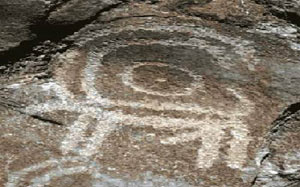 Stone Copper Age
Stone Copper Age
The most frequent animal symbol on the pottery of Ismail Abad Qazvin is the symbol of an antelope, which is sometimes standing and sometimes running, and in some examples it is depicted in numerous herds. On a clay jar from Tel Bakun Marvdasht, the long and wavy horns of an antelope gave it a special glory. The goat symbol in the art of this ancient hill is very diverse.
The symbol of an antelope in Tepe Hesar art is closely related to plants. On the pottery of this area, you can see clusters of plants that grow from the ground and reach under the belly of the goat. Among the long and turned horns of the goat, flowers are also drawn from the front.
On a jar from Silk III, there is a crucifix (perhaps as a symbol of a star) between goats’ horns. The inspiration for this role may have been seeing a star among the horns of a goat standing on the mountain. On another of these pottery, there is a pattern that emphasizes the association of antelope with water and fertility. In this picture, a stream is hanging from the goat’s tail and flowing on the ground. The goat is depicted on the pottery of this period with strength and firmness and as a guardian for the earth.
The same pattern can be seen on pottery from layer VI of Godin Kangavar Hill (4th millennium BC). From this period, there is a tekuki in Gyan Nahavand hill, whose watershed is like the head of a goat
Bronze Age
In the art of Jiroft, the ibex is sometimes seen with pointed straight horns and sometimes with curved horns.
The most examples of antelope symbols in Iran’s Bronze Age can be found on Shahr Sokhte pottery. Except for the pottery famous for the animation of Shahresokhte (narrator of the story of the asuric tree, in the post of sacred plants of ancient Iran), many vessels were made in this hill that depict the continuity of movement in the form of successive frames. On some of them, an antelope is running. One of these pots shows a large herd of goats, the females are depicted with small horns on top (perhaps as an attempt to gain perspective) and the males are depicted with long, turned horns at the bottom.
The symbol of an antelope on Kharelan pottery (I) in Lorestan (2600 BC) is also with a long beard similar to a wheat ear.
Elam
Bezkohi is the most used motif of Susa (I) pottery. The Goat is standing in the middle on the watering troughs of Susa, and its long horns are curled around to protect the earth and water or the earth and plants.
The presence of a group of Darna (a bird that promises spring when it comes) on the top of the dish can be a symbol of the arrival of the green time of the earth and another sign of the connection of these images with fertility and blessings. In order to add to the ritual burden of these paintings, the artists of Susa depicted the tail of a mountain goat as a wheat ear.
In some examples, a group of mountain goats have wrapped their long horns around the ground like a shield, and maybe they are guarding a field or a herd against the attack of a wild animal. Sometimes the goat’s horns are drawn so long to emphasize its strength that it reaches the ground from its back. The importance of these branches is such that sometimes, without depicting an antelope, only its horns are used to show the protective power of earth and water. A terracotta figure from Susa II (3000-3200 BC) clearly places an antelope as a helper of fertilizing forces. Here, the goat is the companion of a god or goddess from whose shoulders water flows on the ground.
Among the masterpieces of Pesha Elami’s metalwork, the symbol of magnificent mountain goat and power is also represented. One of these works is a statue of a sitting Simin goat whose face is made of gold, and the other is a Simin pendant of a standing goat with long vertical horns.
The golden statue of a king from Middle Elam offering a goat to his god shows that the Elamites also considered the mountain goat as a suitable animal for sacrifice. Another work from this period depicts a prayer sitting between two mountain goats.
One of the most important findings of the Elamite period from Chaghamish hill in Khuzestan is a cup made of tar, the handle of which is shaped like a goat standing on two legs. In this period, the mountain goat symbol can also be found in the wall decorations of Choghazanbil and Elamite seals.
Iron Age
Among Marlik’s small bronze figurines, you can see different examples of goat and ram symbols. This role is also repeated on Zarin and Simin Marlik cups. Goat’s head and horns are cast separately in one of these cups and then riveted on the body. The main symbol of Marlik’s Life Cup is also an antelope. In this cup, the artist Marlik has depicted the different stages of this animal’s life in four frames (birth and childhood, middle age, death and rebirth).
An antelope protects leafy flowers between its horns in Babajan iron period pottery of Lorestan.
In Lorestan bronzes, the symbol of an antelope plays a prominent role. In some works, two wild animals (perhaps a leopard) have attacked the goat from both sides, while the goat seems to dominate them with its long horns. The relationship between mountain goats and goddesses is obvious in these works. In a bronze statue, a goat stands on the head of a female deity.
A bronze bridle from Lorestan is decorated with the image of a goddess holding the horns of two goats. The same person with horns (or horned hat) and long earrings can also be seen in other works next to the symbol of an antelope. The goat symbol is also seen on the mysterious bronze statues of Lorestan. Kneeling goats have also been used as knife sharpeners. Several goat heads are mounted on a bronze head from this period.
One of the artistic masterpieces found in the Kalmakre Cave of Lorestan is the Simin tekuki with plant motifs decorated with the head of a sitting goat. An identical example of this work is kept in the Miho Museum without mentioning the place of discovery, which should also be considered as belonging to the treasure of Kalmakre.
 Among the works of two valuable collections of metalwork of the first half of the first millennium BC of Iran, which are kept in the Miho Museum and the Mahbubian Collection, the symbol of an antelope plays a prominent role. Unfortunately, these works were discovered in non-scientific explorations and left the country, and there is no complete information about them, but the author considers most of the objects in these two collections to be smuggled from Kalmakre Cave, Lorestan, based on historical reasons and stylistic reasons (N.K.: Taheri, 1394: 249). The most prominent of these works are goats standing on both sides of palm trees on a ship, a goat guarding the plant of life, and Tekuki with the symbol of a goat standing on the head of a Gharan lion.
Among the works of two valuable collections of metalwork of the first half of the first millennium BC of Iran, which are kept in the Miho Museum and the Mahbubian Collection, the symbol of an antelope plays a prominent role. Unfortunately, these works were discovered in non-scientific explorations and left the country, and there is no complete information about them, but the author considers most of the objects in these two collections to be smuggled from Kalmakre Cave, Lorestan, based on historical reasons and stylistic reasons (N.K.: Taheri, 1394: 249). The most prominent of these works are goats standing on both sides of palm trees on a ship, a goat guarding the plant of life, and Tekuki with the symbol of a goat standing on the head of a Gharan lion.
The symbol of an antelope has a significant presence in Manai art. The clay pots of this area are sometimes made with ram’s head. The symbol of an antelope can also be found in the ivory of Ziwieh’s tusks. Gold pieces with the symbol of an antelope are scattered in several museums of the world, which are mistakenly called pendants, but these pieces were originally designs of the silver tray of Ziwieh, which are now separated from it. A goat is kneeling in front of a lotus flower on some terracotta jars.
The symbol of an antelope is also drawn on the glazed bricks of the Manai Qalaichi Bukan shrine.
Among the surviving works of Northwestern Iranian art in the Iron Age, whose discovery location is unknown, we can mention a terracotta figurine of a warrior antelope, a bronze statue of a standing goat, a silver dish handle, and a bronze censer base.
Achaemenid, Parthian and Sasanian eras
There are many gold cups and tekoks from the Achaemenid period with the head of a goat or a ram. Perhaps the use of ram’s horn by the ancients as a basic container for drinking caused the shape of the horn to be used to make cups later, or the heads of mountain goats were carved on the tekoks. This decorative use can also be related to the ritual guardianship of the mountain goat from the water. The lower part of some of these tekoks is like the bust of an antelope with a hole under the neck. This place is covered with the thumb and when needed, the wine is poured into smaller cups by removing the finger.
Achaemenid artists have also used the symbol of mountain goat and ram to decorate the handles of jars and the rim of cups. Delicate metal examples of goat’s head with twisted horns were made in this period as ornaments or handles of dishes. They have also used this material to make bracelets or arrays of clothes.
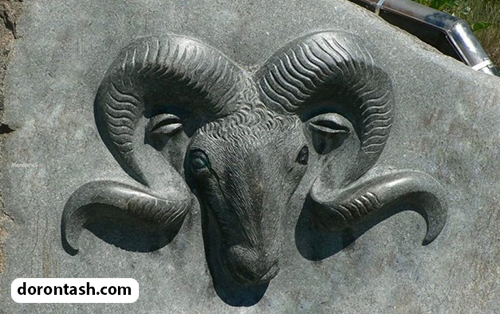 The handle of an Achaemenid sword is decorated with gold like two mountain goats back to back. The representation of this animal can also be seen in Pazyrik art. The use of colorful neck pendants made of glass paste in the shape of a ram’s head was probably used to protect against evil forces in the Achaemenid period.
The handle of an Achaemenid sword is decorated with gold like two mountain goats back to back. The representation of this animal can also be seen in Pazyrik art. The use of colorful neck pendants made of glass paste in the shape of a ram’s head was probably used to protect against evil forces in the Achaemenid period.
The existence of several metal or clay tekoks decorated with the bust of an antelope from the Parthian period shows the stability of this tradition in Iranian art.
The Sassanians also made cups with the symbol of an antelope’s head. A common motif on Sasanian ceramic plates is a ram wearing a shawl or scarf and standing next to the plant of life.
One of the valuable works of art left from the Sassanid period is Simin’s fork with a handle shaped like an antelope’s head. goat horn pattern

goat horn pattern on ancient iran handicrafts

